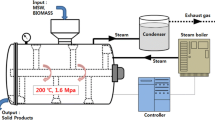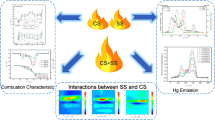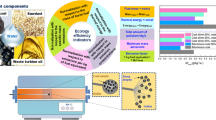Abstract
Coal has long remained a promising and widely used energy resource all over the world. Special emphasis is usually put on the research and development of environmentally friendly technologies for the use of coal and coal processing waste. The development of slurry fuels based on coal waste is one of the promising ways to use raw materials with energy potential, recover wastes, and reduce the environmental load. However, no combustion technology has yet been created for heterogeneous wastes as water-based slurries. The physical principles and parameters of the corresponding processes have not been studied adequately. In this research, the environmental combustion indicators (CO2, CO, H2, NOx, and SO2 concentrations) of slurries based on water and petrochemical, coal, and plant wastes were analyzed for the first time in a wide range of temperatures covering all the typical stages of thermochemical fuel conversion: pyrolysis (400–700 °C), gasification (700–900 °C), and combustion (700–1000 °C). We established the key patterns and aspects of changes in gas concentrations at all the main stages during the thermal decomposition of fuels. The use of water-based fuels at the pyrolysis stage was notable for up to 96% higher concentrations of the key combustible gases (CO, H2). The temperature extrema were 50–100 °C lower than those of bituminous coal. In terms of the key anthropogenic emissions (CO2, NOx, and SO2), the combustion of slurries also appeared to be 20–77% more environmentally friendly than that of coal depending on the temperature conditions and fuel composition. The maximum positive effect from adding biomass to coal-water slurries was achieved in the temperature range of 850 to 1000 °C. The research findings can be used for developing the technologies for thermal recovery of waste as water slurries, in particular, by intensifying the pyrolysis, gasification, and combustion.
Graphical Abstract









Similar content being viewed by others
Data availability
All relevant data are within the manuscript and available from the corresponding author upon request. Supplementary information is available at Environmental Science and Pollution Research’s website.
References
Ahmad AA, Zawawi NA, Kasim FH et al (2016) Assessing the gasification performance of biomass: a review on biomass gasification process conditions, optimization and economic evaluation. Renew Sustain Energy Rev 53:1333–1347. https://doi.org/10.1016/J.RSER.2015.09.030
Akhmetshin MR, Nyashina GS, Strizhak PA (2020) Comparative analysis of factors affecting differences in the concentrations of gaseous anthropogenic emissions from coal and slurry fuel combustion. Fuel 270:117390. https://doi.org/10.1016/j.fuel.2020.117581
Ali MU, Yu Y, Yousaf B et al (2021) Health impacts of indoor air pollution from household solid fuel on children and women. J Hazard Mater 416:126127. https://doi.org/10.1016/j.jhazmat.2021.126127
Anufriev IS (2021) Review of water/steam addition in liquid-fuel combustion systems for NOx reduction: waste-to-energy trends. Renew Sustain Energy Rev 138:110665. https://doi.org/10.1016/J.RSER.2020.110665
Arenillas A, Rubiera F, Pis JJ (1999) Simultaneous thermogravimetric–mass spectrometric study on the pyrolysis behaviour of different rank coals. J Anal Appl Pyrolysis 50:31–46. https://doi.org/10.1016/S0165-2370(99)00024-8
Arenillas A, Rubiera F, Pis JJ et al (2003) Thermal behaviour during the pyrolysis of low rank perhydrous coals. J Anal Appl Pyrolysis 68–69:371–385. https://doi.org/10.1016/S0165-2370(03)00031-7
Armesto L, Bahillo A, Cabanillas A et al (2003) Co-combustion of coal and olive oil industry residues in fluidised bed. Fuel 82:993–1000. https://doi.org/10.1016/S0016-2361(02)00397-6
Bae JS, Lee DW, Park SJ et al (2012) High-pressure gasification of coal water ethanol slurry in an entrained flow gasifier for bioethanol application. Energy Fuels 26:6033–6039. https://doi.org/10.1021/ef301079z
Chen Z, Wang D, Yang H et al (2021) Novel application of red mud as disposal catalyst for pyrolysis and gasification of coal. Carbon Resour Convers 4:10–18. https://doi.org/10.1016/j.crcon.2021.01.001
Cheng Z, Jin H, Liu S et al (2016) Hydrogen production by semicoke gasification with a supercritical water fluidized bed reactor. Int J Hydrogen Energy 41:16055–16063. https://doi.org/10.1016/j.ijhydene.2016.06.075
D’Jesús P, Boukis N, Kraushaar-Czarnetzki B, Dinjus E (2006) Gasification of corn and clover grass in supercritical water. Fuel 85:1032–1038. https://doi.org/10.1016/J.FUEL.2005.10.022
Daood SS, Ord G, Wilkinson T, Nimmo W (2014) Fuel additive technology — NOx reduction, combustion efficiency and fly ash improvement for coal fired power stations. Fuel 134:293–306. https://doi.org/10.1016/j.fuel.2014.04.032
Ding L, Dai Z, Guo Q, Yu G (2017) Effects of in-situ interactions between steam and coal on pyrolysis and gasification characteristics of pulverized coals and coal water slurry. Appl Energy 187:627–639. https://doi.org/10.1016/J.APENERGY.2016.11.086
Ding L, Zhou Z, Guo Q et al (2015) Catalytic effects of Na2CO3 additive on coal pyrolysis and gasification. Fuel 142:134–144. https://doi.org/10.1016/J.FUEL.2014.11.010
Dorokhov VV, Kuznetsov GV, Nyashina GS, Strizhak PA (2021a) Composition of a gas and ash mixture formed during the pyrolysis and combustion of coal-water slurries containing petrochemicals. Environ Pollut 285:117390. https://doi.org/10.1016/J.ENVPOL.2021.117390
Dorokhov VV, Kuznetsov GV, Vershinina KY, Strizhak PA (2021b) Relative energy efficiency indicators calculated for high-moisture waste-based fuel blends using multiple-criteria decision-making. Energy 234:121257. https://doi.org/10.1016/J.ENERGY.2021.121257
Fan Y, Wang R, Sun J et al (2020) An effective recycle way of waste coke ash and coking wastewater for preparing coke ash coking wastewater slurry. Sci Total Environ 742:140581. https://doi.org/10.1016/j.scitotenv.2020.140581
Feng T, Huo M, Zhao X et al (2017) Reduction of SO2 to elemental sulfur with H2 and mixed H2/CO gas in an activated carbon bed. Chem Eng Res Des 121:191–199. https://doi.org/10.1016/j.cherd.2017.03.014
Gaber C, Wachter P, Demuth M, Hochenauer C (2020) Experimental investigation and demonstration of pilot-scale combustion of oil-water emulsions and coal-water slurry with pronounced water contents at elevated temperatures with the use of pure oxygen. Fuel 282:118692. https://doi.org/10.1016/j.fuel.2020.118692
Glushkov DO, Paushkina KK, Shabardin DP (2020) Co-combustion of coal processing waste, oil refining waste and municipal solid waste: mechanism, characteristics, emissions. Chemosphere 240:124892. https://doi.org/10.1016/j.chemosphere.2019.124892
Gu S, Xu Z, Ren Y et al (2021) An approach for upgrading lignite to improve slurryability: blending with direct coal liquefaction residue under microwave-assisted pyrolysis. Energy 222:120012. https://doi.org/10.1016/J.ENERGY.2021.120012
Guo F, Zhong Z (2018) Co-combustion of anthracite coal and wood pellets: thermodynamic analysis, combustion efficiency, pollutant emissions and ash slagging. Environ Pollut 239:21–29. https://doi.org/10.1016/j.envpol.2018.04.004
Hu G, Dam-Johansen K, Wedel S, Hansen JP (2006) Decomposition and oxidation of pyrite. Prog Energy Combust Sci 32:295–314. https://doi.org/10.1016/j.pecs.2005.11.004
Huang J, Opoku PA, Guang L, et al (2021) A multi-emission analysis of organic and inorganic pollutants during the combustion of sludge with high and low calorific value coals. Environ Sci Pollut Res 1–11.https://doi.org/10.1007/S11356-021-15301-7
Janajreh I, Adeyemi I, Raza SS, Ghenai C (2021) A review of recent developments and future prospects in gasification systems and their modeling. Renew Sustain Energy Rev 138:110505. https://doi.org/10.1016/j.rser.2020.110505
Jiao T, Fan H, Liu S et al (2021) A review on nitrogen transformation and conversion during coal pyrolysis and combustion based on quantum chemical calculation and experimental study. Chinese J Chem Eng 35:107–123. https://doi.org/10.1016/J.CJCHE.2021.05.010
Kim H, Kim B, Lim H, Song J (2021) Effect of liquid carbon dioxide on coal pyrolysis and gasification behavior at subcritical pressure conditions. Chem Eng Sci 231:116292. https://doi.org/10.1016/J.CES.2020.116292
Lázaro MJ, Moliner R, Suelves I et al (2002) Co-pyrolysis of a mineral waste oil/coal slurry in a continuous-mode fluidized bed reactor. J Anal Appl Pyrolysis 65:239–252. https://doi.org/10.1016/S0165-2370(02)00003-7
Ledesma EB, Li CZ, Nelson PF, Mackie JC (1998) Release of HCN, NH3, and HNCO from the thermal gas-phase cracking of coal pyrolysis tars. Energy Fuels 12:536–541. https://doi.org/10.1021/EF970147K
Lee JW, Chung SW, Lee SJ et al (2014) Characteristics of coal slurry gasification under partial slagging operating condition. Korean Chem Eng Res 52:657–666. https://doi.org/10.9713/kcer.2014.52.5.657
Li D, Wu D, Xu F et al (2018) Literature overview of Chinese research in the field of better coal utilization. J Clean Prod 185:959–980. https://doi.org/10.1016/j.jclepro.2018.02.216
Li Q, Ye H, Wang Z et al (2021) Characteristics and evolution of products under moderate and high temperature coal pyrolysis in drop tube furnace. J Energy Inst 96:121–127. https://doi.org/10.1016/J.JOEI.2021.03.010
Lin B, Wang J, Huang Q, Chi Y (2017a) Effects of potassium hydroxide on the catalytic pyrolysis of oily sludge for high-quality oil product. Fuel 200:124–133. https://doi.org/10.1016/J.FUEL.2017.03.065
Lin JY, Zhang S, Zhang L et al (2010) HCN and NH3 formation during coal/char gasification in the presence of NO. Environ Sci Technol 44:3719–3723. https://doi.org/10.1021/ES1001538
Lin Y, Liao Y, Yu Z et al (2017b) The investigation of co-combustion of sewage sludge and oil shale using thermogravimetric analysis. Thermochim Acta 653:71–78. https://doi.org/10.1016/J.TCA.2017.04.003
Ma L, Wang T, Liu J et al (2019) Effect of different conditions on the combustion interactions of blended coals in O2/CO2 mixtures. J Energy Inst 92:413–427. https://doi.org/10.1016/J.JOEI.2018.05.006
Manwatkar P, Dhote L, Pandey RA et al (2021) Combustion of distillery sludge mixed with coal in a drop tube furnace and emission characteristics. Energy 221:119871. https://doi.org/10.1016/j.energy.2021.119871
Merryman EL, Levy A (1975) Nitrogen oxide formation in flames: the roles of NO2 and fuel nitrogen. Symp Combust 15:1073–1083. https://doi.org/10.1016/S0082-0784(75)80372-9
Miller JA, Bowman CT (1989) Mechanism and modeling of nitrogen chemistry in combustion. Prog Energy Combust Sci 15:287–338. https://doi.org/10.1016/0360-1285(89)90017-8
Neves D, Thunman H, Matos A et al (2011) Characterization and prediction of biomass pyrolysis products. Prog Energy Combust Sci 37:611–630. https://doi.org/10.1016/j.pecs.2011.01.001
Nyashina GS, Kuznetsov GV, Strizhak PA (2020) Effects of plant additives on the concentration of sulfur and nitrogen oxides in the combustion products of coal-water slurries containing petrochemicals. Environ Pollut 258:113682. https://doi.org/10.1016/j.envpol.2019.113682
Oh G, Ra HW, Yoon SM et al (2019) Syngas production through gasification of coal water mixture and power generation on dual-fuel diesel engine. J Energy Inst 92:265–274. https://doi.org/10.1016/J.JOEI.2018.01.009
Oliveira MLS, Navarro OG, Crissien TJ et al (2017) Coal emissions adverse human health effects associated with ultrafine/nano-particles role and resultant engineering controls. Environ Res 158:450–455. https://doi.org/10.1016/J.ENVRES.2017.07.002
Park DC, Day SJ, Nelson PF (2005) Nitrogen release during reaction of coal char with O2, CO2, and H2O. Proc Combust Inst 30:2169–2175. https://doi.org/10.1016/J.PROCI.2004.08.051
Peng X, Ma X, Xu Z (2015) Thermogravimetric analysis of co-combustion between microalgae and textile dyeing sludge. Bioresour Technol 180:288–295. https://doi.org/10.1016/J.BIORTECH.2015.01.023
Ranjan A, Mandal KK, Kumari P (2020) Impact of coal-fired thermal power plant on the drinking water quality of Anpara, Sonbhadra, Uttar Pradesh. India Groundw Sustain Dev 11:100395. https://doi.org/10.1016/j.gsd.2020.100395
Ren Y, Zheng J, Xu Z et al (2018) Petroleum coke facilitate the upgrade of lignite under microwave irradiation for slurryability improvement. Fuel 223:414–421. https://doi.org/10.1016/j.fuel.2018.03.001
Staroń A, Kowalski Z, Staroń P, Banach M (2019) Studies on CWL with glycerol for combustion process. Environ Sci Pollut Res 26:2835–2844. https://doi.org/10.1007/s11356-018-3814-0
Sverchkov I, Chukaeva M, Matveeva V (2022) Influence of preparation and combustion parameters of coal-water slurries on gas emission chemistry. Environ Sci Pollut Res 1–12.https://doi.org/10.1007/S11356-022-19038-9/FIGURES/9
Svoboda K, Pohořelý M, Jeremiáš M et al (2012) Fluidized bed gasification of coal–oil and coal–water–oil slurries by oxygen–steam and oxygen–CO2 mixtures. Fuel Process Technol 95:16–26. https://doi.org/10.1016/J.FUPROC.2011.11.001
Tamošiūnas A, Gimžauskaitė D, Aikas M et al (2019) Gasification of waste cooking oil to syngas by thermal arc plasma. Energies 12:2612. https://doi.org/10.3390/EN12132612
Tsubouchi N, Ohtsuka Y (2002) Nitrogen release during high temperature pyrolysis of coals and catalytic role of calcium in N2 formation. Fuel 81:2335–2342. https://doi.org/10.1016/S0016-2361(02)00173-4
Uçar S, Özkan AR, Karagöz S (2016) Co-pyrolysis of waste polyolefins with waste motor oil. J Anal Appl Pyrolysis 119:233–241. https://doi.org/10.1016/j.jaap.2016.01.013
Vamvuka D, Salpigidou N, Kastanaki E, Sfakiotakis S (2009) Possibility of using paper sludge in co-firing applications. Fuel 88:637–643. https://doi.org/10.1016/J.FUEL.2008.09.029
Vershinina KY, Shlegel NE, Strizhak PA (2019) Relative combustion efficiency of composite fuels based on of wood processing and oil production wastes. Energy 169:18–28. https://doi.org/10.1016/j.energy.2018.12.027
Wan G, Yu J, Wang X, Sun L (2022) Study on the pyrolysis behavior of coal-water slurry and coal-oil-water slurry. J Energy Inst 100:10–21. https://doi.org/10.1016/J.JOEI.2021.10.006
Wang J, Zhang B, Zhong Z et al (2017) Catalytic fast co-pyrolysis of bamboo residual and waste lubricating oil over an ex-situ dual catalytic beds of MgO and HZSM-5: analytical PY-GC/MS study. Energy Convers Manag 139:222–231. https://doi.org/10.1016/J.ENCONMAN.2017.02.047
Wang Z, Hong C, Xing Y et al (2018) Combustion behaviors and kinetics of sewage sludge blended with pulverized coal: with and without catalysts. Waste Manag 74:288–296. https://doi.org/10.1016/J.WASMAN.2018.01.002
Werther J, Saenger M, Hartge EU et al (2000) Combustion of agricultural residues. Prog Energy Combust Sci 26:1–27. https://doi.org/10.1016/S0360-1285(99)00005-2
Xiao H, Cheng Q, Shi H et al (2020) The enhanced SO3 formation by alkali-metal sulfates from ash in the post-flame region during the combustion of high-alkali coal. Environ Sci Pollut Res 27:9771–9779. https://doi.org/10.1007/S11356-020-07604-Y/FIGURES/8
Xinjie L, Shihong Z, Xincheng W et al (2021) Co-combustion of wheat straw and camphor wood with coal slime: thermal behaviour, kinetics, and gaseous pollutant emission characteristics. Energy 234:121292. https://doi.org/10.1016/j.energy.2021.121292
Xiu M, Stevanovic S, Rahman MM et al (2018) Emissions of particulate matter, carbon monoxide and nitrogen oxides from the residential burning of waste paper briquettes and other fuels. Environ Res 167:536–543. https://doi.org/10.1016/J.ENVRES.2018.08.008
Xu H, Smoot LD, Hill SC (1999) Computational model for NOx reduction by advanced reburning. Energy Fuels 13:411–420. https://doi.org/10.1021/ef980090h
Yang X, Luo Z, Liu X et al (2021) Experimental and numerical investigation of the combustion characteristics and NO emission behaviour during the co-combustion of biomass and coal. Fuel 287:119383. https://doi.org/10.1016/j.fuel.2020.119383
Zhan M, Sun C, Chen T (2019) Li X (2019) Emission characteristics for co-combustion of leather wastes, sewage sludge, and coal in a laboratory-scale entrained flow tube furnace. Environ Sci Pollut Res 2610(26):9707–9716. https://doi.org/10.1007/S11356-019-04347-3
Zhang Q, Zheng Y, Tong D et al (2019) Drivers of improved PM2.5 air quality in China from 2013 to 2017. Proc Natl Acad Sci 116:24463–24469. https://doi.org/10.1073/pnas.1907956116
Zhao N, Li B, Li H et al (2021) The potential co-benefits for health, economy and climate by substituting raw coal with waste cooking oil as a winter heating fuel in rural households of northern China. Environ Res 194:110683. https://doi.org/10.1016/J.ENVRES.2020.110683
Zhao R, Qin J, Chen T et al (2020) Experimental study on co-combustion of low rank coal semicoke and oil sludge by TG-FTIR. Waste Manag 116:91–99. https://doi.org/10.1016/J.WASMAN.2020.08.007
Zhao Z, Wang R, Wu J et al (2019) Bottom ash characteristics and pollutant emission during the co-combustion of pulverized coal with high mass-percentage sewage sludge. Energy 171:809–818. https://doi.org/10.1016/j.energy.2019.01.082
Zhou H, Li Y, Li N et al (2019) Conversions of fuel-N to NO and N2O during devolatilization and char combustion stages of a single coal particle under oxy-fuel fluidized bed conditions. J Energy Inst 92:351–363. https://doi.org/10.1016/j.joei.2018.01.001
Zhou Y, Huang D, Lang J et al (2021) Improved estimation of rural residential coal emissions considering coal-stove combinations and combustion modes. Environ Pollut 272:115558. https://doi.org/10.1016/j.envpol.2020.115558
Zhou Z, Guo L, Chen L et al (2018) Study of pyrolysis of brown coal and gasification of coal-water slurry using the ReaxFF reactive force field. Int J Energy Res 42:2465–2480. https://doi.org/10.1002/er.4029
Funding
This work was supported by the Russian Foundation for Basic Research, National Council of Brazil for Scientific and Technological Development and Ministry of Science & Technology Government of India (grant number 19–53-80019).
Author information
Authors and Affiliations
Contributions
D. V.: methodology, investigation, visualization. R. D.: investigation, visualization. N. G.: methodology, formal analysis, investigation, visualization, writing—original draft. S. P.: funding acquisition, resources, conceptualization, supervision, writing—review and editing.
Corresponding author
Ethics declarations
Ethics approval and consent to participate
Not applicable.
Consent for publication
Not applicable.
Competing interests
The authors declare no competing interests.
Additional information
Responsible Editor: Shimin Liu
Publisher's note
Springer Nature remains neutral with regard to jurisdictional claims in published maps and institutional affiliations.
Supplementary Information
Below is the link to the electronic supplementary material.
Supplementary file1 (MP4 1351 KB)
Rights and permissions
Springer Nature or its licensor (e.g. a society or other partner) holds exclusive rights to this article under a publishing agreement with the author(s) or other rightsholder(s); author self-archiving of the accepted manuscript version of this article is solely governed by the terms of such publishing agreement and applicable law.
About this article
Cite this article
Nyashina, G., Dorokhov, V., Romanov, D. et al. Gas composition during thermochemical conversion of dry solid fuels and waste-derived slurries. Environ Sci Pollut Res 30, 24192–24211 (2023). https://doi.org/10.1007/s11356-022-23824-w
Received:
Accepted:
Published:
Issue Date:
DOI: https://doi.org/10.1007/s11356-022-23824-w




